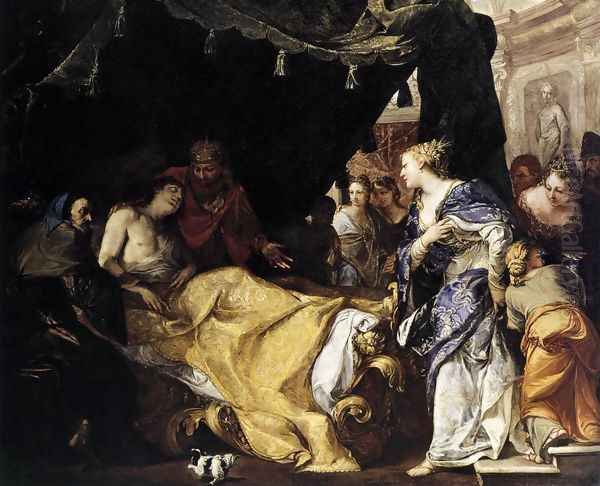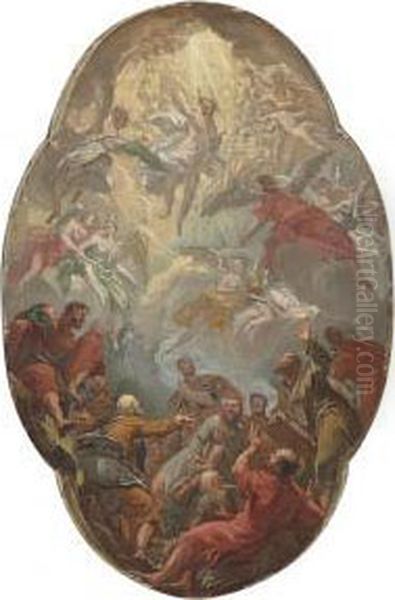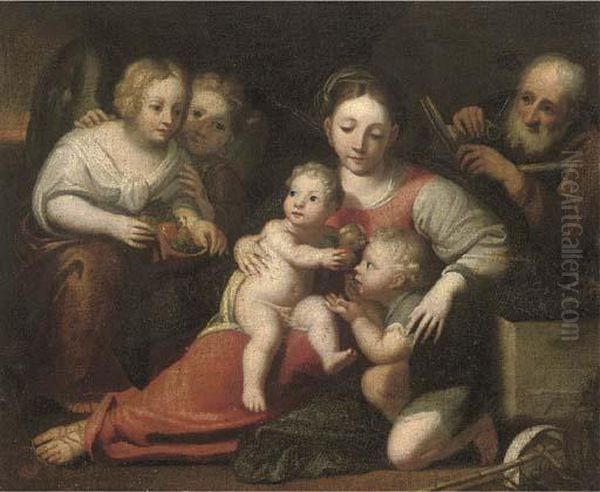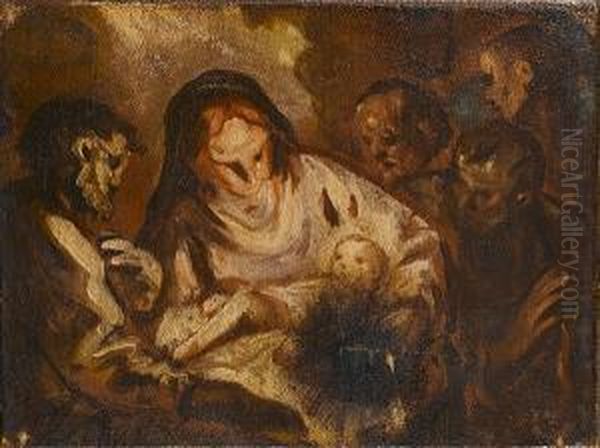
Antonio Bellucci stands as a significant figure in the transition from the grandeur of the late Baroque to the lighter elegance of the Rococo. Born in Pieve di Soligo, near Treviso in the Veneto region of Italy, in 1654, his life and prolific career spanned a period of immense artistic change. Bellucci became renowned not only within Italy but across the major courts and cities of Europe, including Vienna, Düsseldorf, and London, leaving behind a legacy of vibrant decorative schemes and masterful easel paintings. His ability to synthesize the rich colorism of the Venetian tradition with the demands of international patrons made him one of the most sought-after Italian painters of his time. He passed away in his hometown in 1726, concluding a career marked by extensive travel, prestigious commissions, and a distinctive artistic voice.
Early Life and Venetian Formation
Antonio Bellucci's artistic journey began not in Venice itself, but reportedly under the tutelage of Domenico Difnico in Sebenico (modern-day Šibenik, Croatia), which was then under Venetian influence. This early training grounded him in the fundamentals that would blossom during his subsequent immersion in the thriving artistic environment of Venice. The city, still a major European cultural hub, provided fertile ground for the young artist.
In Venice, Bellucci absorbed the powerful legacy of the 16th-century masters, particularly the dramatic compositions and rich palettes of Paolo Veronese and Titian. He also engaged with the prevailing trends of his own time, learning from contemporary Venetian painters. Artists like Antonio Zanchi and Andrea Celesti, known for their dynamic, sometimes tenebrist, late Baroque works, likely influenced his early development. Bellucci quickly developed a reputation for his skillful handling of paint, his appealing use of color, and his ability to manage large-scale compositions, qualities that would soon attract attention beyond the Veneto.
The International Stage: Vienna and the Holy Roman Empire

Bellucci's ambition and talent led him beyond Italy relatively early in his career. Around the late 1680s or early 1690s, he traveled north, finding significant patronage within the Holy Roman Empire, particularly in Vienna. The Habsburg capital was a center of power and wealth, eager to embellish its palaces and religious institutions with the fashionable Italian style. Bellucci arrived at a time when grand decorative painting was highly prized.
Between 1695 and 1704, Bellucci undertook important commissions in Austria. Notably, he painted four large altarpieces depicting saints for the Augustinian Monastery at Klosterneuburg, near Vienna. These works demonstrate his mastery of religious narrative and his ability to create imposing, yet graceful, compositions suitable for ecclesiastical settings. His success extended to secular projects; he contributed significantly to the decoration of the Liechtenstein Garden Palace in Vienna, working for Prince Johann Adam Andreas von Liechtenstein. His ceiling frescoes there, often depicting mythological or allegorical themes, showcased his burgeoning Rococo sensibilities – lighter palettes, dynamic movement, and elegant figures – while retaining a Baroque sense of scale and drama. His work was favored by Emperor Joseph I, solidifying his status as a leading decorative painter in the imperial city.
Service to the Elector Palatine in Düsseldorf
Following his successful period in Vienna (with intermittent returns to Venice), Bellucci's reputation attracted another major patron: Johann Wilhelm, the Elector Palatine. From around 1705, Bellucci spent several years working primarily in Düsseldorf, the Elector's capital. Johann Wilhelm was an avid art collector and patron, transforming Düsseldorf into a significant cultural center. He employed several leading artists, creating a competitive yet stimulating environment.
Bellucci was commissioned to execute extensive decorative schemes, most notably for the Elector's Schloss Bensberg. Here, alongside contemporaries like Giovanni Antonio Pellegrini, Bellucci created ceiling paintings and other decorations that exemplified the high international Rococo style. His works for Johann Wilhelm often featured complex allegories and mythological scenes, rendered with the characteristic warmth, fluidity, and sophisticated color harmonies that defined his mature style. This period cemented Bellucci's fame across German-speaking lands and demonstrated his adaptability to the specific tastes and requirements of different patrons and settings. His ability to work effectively on large-scale projects made him invaluable to rulers seeking to express their magnificence through art.
The English Sojourn: Patronage of the Duke of Chandos

In 1716, seeking new opportunities, Antonio Bellucci moved to England, arriving at a time when wealthy British patrons eagerly sought the skills of continental, particularly Italian, artists for decorating their newly built mansions and palaces. He followed in the footsteps of other successful Venetian painters like Sebastiano Ricci and Giovanni Antonio Pellegrini, who had already found favor in London.
Bellucci's most significant patron in England was James Brydges, the 1st Duke of Chandos. The Duke was building an opulent mansion called Cannons in Middlesex (near Edgware) and required lavish decoration. Bellucci was employed between 1716 and 1722, contributing significantly to the interior schemes. His most celebrated works at Cannons were the ceiling paintings for the Duke's chapel (now the church of St. Lawrence, Whitchurch), depicting scenes like the Nativity and the Ascension, and the Descent of the Holy Ghost. These works are considered among the finest examples of Italian decorative painting in England from this period, showcasing Bellucci's mature style – elegant figures, bright illumination, and harmonious compositions perfectly integrated with the architecture. Some sources also suggest he worked at Burlington House in London. Though Cannons itself was dismantled shortly after the Duke's death, the paintings preserved in St. Lawrence serve as a testament to Bellucci's successful English period.
Artistic Style and Influences
Antonio Bellucci's style is best characterized as a bridge between the Late Baroque and the emerging Rococo. He retained the compositional grandeur, dramatic potential, and rich textures associated with the Baroque, particularly the Venetian tradition stemming from Veronese. However, he increasingly incorporated the lighter palette, graceful movement, asymmetrical designs, and emphasis on elegance and charm that define the Rococo.
His handling of color is particularly noteworthy. He employed warm, luminous hues, often achieving a soft, atmospheric effect. His figures, whether in religious, historical, or mythological scenes, are typically rendered with a sense of grace and fluidity. While capable of depicting intense emotion, his overall tone often leans towards a pleasing theatricality rather than deep pathos. His work shows less of the dramatic intensity of some Baroque predecessors like Luca Giordano, and more affinity with the decorative elegance pursued by contemporaries like Sebastiano Ricci and Jacopo Amigoni.

The influence of Paolo Veronese is palpable throughout his career, especially in his large multi-figure compositions and his use of architectural settings. Titian's mastery of color also left its mark. Among his contemporaries, he shared the international stage with Ricci and Pellegrini, often competing for similar commissions. While distinct in their individual styles, all three contributed to the dissemination of the Venetian decorative style across Europe. Bellucci's work, perhaps less dynamically energetic than Ricci's or as ethereally light as Pellegrini's at times, possesses a solid draftsmanship and a consistently pleasing harmony of color and form. He certainly paved the way for the next generation, including the greatest Venetian decorator, Giovanni Battista Tiepolo, whose early work shows an awareness of Bellucci's achievements.
Key Works and Themes
Antonio Bellucci's oeuvre encompasses a wide range of subjects, primarily large-scale decorative works for ceilings and walls, altarpieces, and easel paintings featuring historical, mythological, and religious themes. Several works stand out as representative of his skill and style.
The Family of Darius before Alexander the Great, now housed in the Ashmolean Museum, Oxford, is a fine example of his historical painting. It showcases his ability to handle a complex narrative with multiple figures, balancing emotional expression with compositional clarity and rich detail, clearly echoing Veronese's famous treatment of the same subject.
Antiochus and Stratonice (c. 1700), located in the Gemäldegalerie Alte Meister, Kassel, depicts the Hellenistic story of Prince Antiochus falling ill due to his forbidden love for his stepmother, Stratonice. Bellucci captures the dramatic tension and psychological nuances of the scene with characteristic elegance and sophisticated color.
His ceiling paintings represent a major part of his output. The surviving works at St. Lawrence, Whitchurch (formerly the chapel at Cannons), including the Adoration of the Name of God and scenes from the life of Christ, are crucial examples of his English period. Similarly, his frescoes in the Liechtenstein Garden Palace in Vienna demonstrate his mastery of ceiling decoration in a palatial setting. His work at Schloss Bensberg for the Elector Palatine further solidified his reputation in this demanding genre.
Religious themes remained central throughout his career, evident in the Klosterneuburg altarpieces and numerous other works, including depictions of the Holy Family, a subject he treated with warmth and tenderness, reflecting popular devotional sentiments of the time. His consistent ability to adapt his style to suit both sacred and secular contexts was key to his international success.
Later Years and Legacy
After a successful period abroad, particularly his six years in England, Antonio Bellucci returned to his native Veneto around 1722. He spent the final years of his life in his birthplace, Pieve di Soligo, where he died in 1726. Some accounts suggest his later years may have involved legal or financial difficulties, though concrete details remain scarce. His son, Giovanni Battista Bellucci, also became a painter, though less renowned than his father.

Antonio Bellucci's legacy lies in his role as a key transitional figure between Baroque and Rococo, and as a major exporter of the Venetian decorative style. His work successfully blended the coloristic tradition of Venice with the lighter, more elegant tastes emerging across Europe. He demonstrated that Italian artists could adapt and thrive in diverse international contexts, from the imperial court in Vienna to the Elector's palace in Düsseldorf and the aristocratic mansions of England.
His influence can be seen in the development of Rococo painting in the regions where he worked. While perhaps overshadowed in art historical narratives by the slightly later and more dazzling innovations of Tiepolo, Bellucci played a crucial role in maintaining the prestige of large-scale Italian decorative painting abroad during the early 18th century. His numerous commissions and the sheer geographical spread of his activity attest to his contemporary fame and the high regard in which his art was held.
Contemporaries and Artistic Milieu
Antonio Bellucci operated within a vibrant and competitive European art world. His career intersected with numerous important artists, both influences and contemporaries. His teacher, Domenico Difnico, provided his initial training. In Venice, he would have been aware of older masters like Antonio Zanchi and Andrea Celesti, and contemporaries like Gregorio Lazzarini (who later taught Tiepolo).
The towering figures of the Venetian Renaissance, Titian and especially Paolo Veronese, remained constant points of reference for Bellucci, particularly for large-scale compositions. The influence of late Baroque masters active in Italy, such as Luca Giordano, known for his rapid execution and vast decorative schemes, can also be discerned.
His most direct contemporaries and sometimes rivals on the international stage were fellow Venetians Sebastiano Ricci and Giovanni Antonio Pellegrini. All three travelled extensively, securing major commissions in Vienna, Germany, and England, often working for the same patrons. Jacopo Amigoni was another Venetian contemporary who enjoyed a successful international career slightly later. Bellucci's style is often compared to theirs – sharing a Venetian foundation but differing in handling and temperament. The celebrated pastellist Rosalba Carriera was also a contemporary in Venice.
In the regions he visited, he would have encountered local artists. In Vienna, figures like Martino Altomonte and Johann Michael Rottmayr were prominent. His work, alongside that of Ricci and Pellegrini, significantly impacted the development of the Rococo style in Austria and Germany. Ultimately, Bellucci's career paved the way for the culminating figure of Venetian decorative painting, Giovanni Battista Tiepolo, who built upon the international networks and stylistic developments established by Bellucci and his generation.
Conclusion

Antonio Bellucci was a highly accomplished and internationally successful painter whose career exemplifies the dynamism of European art in the late 17th and early 18th centuries. Born and trained in the Venetian tradition, he skillfully adapted his art to meet the demands of patrons across Austria, Germany, and England. His style elegantly navigated the transition from the robust energy of the Baroque to the refined grace of the Rococo, characterized by warm colors, fluid compositions, and skilled draftsmanship. Through prestigious commissions for palaces, churches, and monasteries, Bellucci left an indelible mark on the artistic landscape of Europe, solidifying his place as a significant master of his time and a key figure in the dissemination of the Venetian decorative tradition. His work continues to be admired for its beauty, technical assurance, and historical importance.